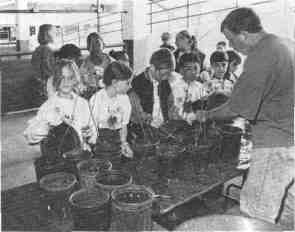
During an Earth Day celebration, fourth grade students from Springfield learn the proper way to plant trees with a "hands- on" project.
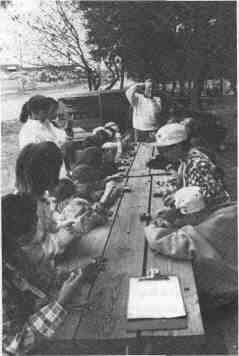
A woman dressed in the buckskin garb of a Native American, her voice explaining the past in a rhythmic cadence, casts a grandmotherly look upon the children who have gathered under the trees. They've come to hear her stories, and to see and touch the kind of deerskin blankets, stretched-hide drums, and bone, horn and shell tools crafted by Illinois' first residents. These people, she tells them, well understood the importance of deer, fish, trees and the other natural resources that surrounded them. To waste a resource was to squander an inheritance left for them by their ancestors.
In another part of Illinois, a teacher tells her students to enter an Internet address on their computers—http: //dnr.state.il.us/ nredu.kids/kids.htm—and to click on that site's first hyperlink, "Wild about Illinois Organisms and Ecosystems." From there, she says they can pick whatever topic, from bird migration to prairies, they want to learn about that day.
To reach out to youngsters, the Department of Natural Resources' Education Division will step back into the past or tap into the latest technology. The point, says Educational Services Section head Kathy Andrews, is to get youngsters involved.
"We want to provide support services for educators so they can try to get kids to relate to natural resources," Andrews said. "If we provide user-friendly materials, teachers are more likely to use them."
The services and materials include education kits, workshops, poster contests, a twice yearly publication, Earth Day fairs, Conservation Field Day events and a variety of materials available in printed form and on the Internet. One section of the Education Division also oversees site interpretive programs at 21 state parks, in which seeing, touching, smelling and listening are emphasized to school children participating in park activities and programs.
In addition, the divisions safety education section trains volunteer hunting, trapping, boating and snowmobiling instructors to teach mandatory safety education classes for youths. Still another section handles public events and promotions, including youth hunts and youth fishing tournaments, plus annual family-oriented events at state parks such as the Fort Massac Encampment in Metropolis and Red Hills Old Settler Days in Sumner.
Tom Clay, who heads the Education Division within the Office of Land Management and Education, notes the 1995 decision to integrate the Department's education efforts has helped send a singular message.
"Every effort is being made to emphasize the importance of stewardship and ecological connectivity to our children," Clay said. "As we enter the 21st century, the goal of natural resource educators should be to provide todays youth with the opportunity to develop an appreciation and knowledge of our natural resources and the skills needed to make sound resource decisions. As tomorrows stewards of the land, their knowledge should be based on sound scientific principles that recognize both the fragile and the essential connectivity between humans and the earth."
That philosophy extends to DNR's Natu-
March/April 1998 ¦ 43
OUR NATURAL RESOURCES
ral History Survey, State Geological Survey,
State Water Survey and Waste Management
and Research Center, all of which offer educational materials geared for youngsters. It
also reaches to the divisions of Wildlife, Fisheries, Forest Resources and Natural Heritage,
which have produced informational posters,
activities and brochures with younger conservationists in mind.
However, the Division of Education is the Department's mainstay in sustaining regular contact with Illinois youngsters through its colorful Kids for Conservation™ periodical, which is published twice a year and sent free of charge to member families with children between the ages of 5 and 13. It includes stories, games, puzzles and artwork submitted by its youthful subscribers.
The Education Division also is in charge of developing educational materials, working with the State Board of Education to ensure the materials meet State Goals for Learning, and distributing them to all public and private schools in the state. Four such learning kits have been produced since 1991, each containing lesson plans, an audiotape, a close-captioned video, posters, activity sheets and other materials. "Wild Mammals of Illinois" is adaptable to grades K-8, "Kids for Trees" for grades K-3, "Illinois Birds" for grades 3-6 and "Resource Conservation" for grades 7-10. Some of the kits' lesson plans are available through the Departments Web site, http: //dnr.state.il.us.
A fifth kit, "Aquatic Illinois," is planned for release within the next few months. Geared for grades 5-9, it's the first kit that will be supplemented by a CD-ROM for use on personal computers. Andrews says the CD-ROM, which be available at the start of the next school year, is being produced in conjunction with EcoWatch, a DNR program that coordinates data collection by trained volunteers.
"The CD-ROM will feature a continuation of lessons that will make for a stronger unit, but it also can be used singularly," she said. "For younger users, there will games involving aquatic and forest habitats, and for older kids, there will be an introduction to RiverWatch," a citizen-based stream-monitoring program.
The Education Division often works in partnership with the Environmental Education Association of Illinois, a group that promotes environmental awareness and understanding to people of all ages. EEAI's efforts brought to Illinois four national conservation and environmental education programs that the Department of Natural Resources administers—Project WILD, Project WILD Aquatic, Project WET and Project Learning Tree.
Project WILDs 113 activities are designed to stimulate elementary and secondary school students into thinking how terrestrial wildlife function within their habitats. For example, in the role-playing activity "Oh, Deer," participants learn how food, water and shelter affect a herds ability to reproduce and survive over time. Project WILD Aquatic is a continuation of Project WILD dealing with aquatic wildlife and their habitats. The activities in Project WET involve waters role in the world, water history, water quality and water conservation. Trees and forestry are the basis for learning about environmental stewardship in the Project Learning Tree program.
An offshoot of Project WILD is the Illinois Action Grant program, a cooperative effort of DNR, the State Board of Education and EEAI. Schools, nature centers and youth groups are eligible to apply for grant assistance up to $500 for use in developing or enhancing habitat areas, which can then be used as outdoor classrooms. Interest earned from stock given by the Jadel family to the Illinois Conservation Foundation funds the grants.

During an Earth Day
celebration, fourth
grade students from
Springfield learn the
proper way to plant
trees with a "hands-
on" project.
A requirement of action grant recipients is that a teacher who has attended any of the four Project workshops must be involved in the proposed habitat project. Andrews says attending workshops is a way teachers can feel at ease in teaching natural resources- based curriculum.
"We need to provide user-friendly materials so teachers can become comfortable in teaching about Illinois habitat and wildlife," she said. Some teachers may put their environmental emphasis on rain forests, for example, but Andrews says the Divisions materials are an effort to "bring environmental education topics back to Illinois."
She says interest currently is high for prairies, prompting the Department to create a prairie coloring sheet. Another popular item, available on loan to teachers, are "Tree Trunks" education kits targeted for grades 3-6 that feature lesson plans, posters, videos, books and wood samples. Such items are among dozens the Department makes available to individuals, classrooms, youth groups, scouting councils and other groups.
Among items the section distributes annually are contest kits for the National Arbor Day poster contest for fifth graders. Each fall, the Education Services Section mails contest kits containing lessons plans to all Illinois schools having fifth grade classes. The kits are an introduction to forests, tree diversity and tree planting and provide the rules for submitting posters for a state competition held each spring. Illinois' winning poster goes on to compete at the national level.
Another educational program that serves double duty as an art contest is the Junior
44 ¦ Illinois Parks and Recreation
OUR NATURAL RESOURCES
Duck Stamp design contest for grades K-12,
which the Education Division oversees at the
state level. Students compete statewide in
four grade categories, with the "best of show"
winning entry entered into the national competition. The contest promotes wetland and
waterfowl conservation through its educational curriculum, with contest rules requiring that poster entries are submitted by
schools.
Excluding workshops and state fairs, the Educational Services Section answered requests for 94, 000 pieces of literature during calendar year 1997, 66 percent of which were requested by educators, 22 percent from DNR sites and park districts, 7 percent from youth group leaders and 5 percent from children. Andrews says inquiries from educators are especially welcome because it gives staff opportunities for suggesting how conservation education can be incorporated into their daily lessons.
"Teachers who say there's not enough time in the day don't recognize that conservation education can be their science, math or language arts lesson," Andrews said. "They need to mesh it, to weave it into their daily lessons plans."
Recognizing that computers will play an ever-increasing role in students' lives, Andrews says the Department will continue to use new technologies to promote an appreciation for natural resources.
"After designing things to excite them, we'll encourage them to shut off the computer and get outside," Andrews said, "to take a drive, to visit a state park, to see the real world."
ANNE MUELLER
is a staff writer for Outdoorlllinois. a publication of the Illinois
Department of Natural Resources. This article is reprinted with
permission from the March 1998 issue of Outdoorlllinois.
Where Learning Is Fun
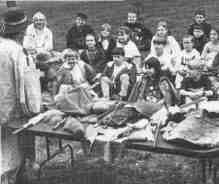
Turn to the "What's Happening" calendar of events in any issue of
Outdoorlllinois, and you'll find a world
of exploration offered by DNR's site
interpretive programs. One month
might offer costumed characters describing the I&M Canal in its heyday. Another might feature a scavenger hunt centering on Volo Bogs most
secretive creatures. Pere Marquette
State Park might be pointing out wild
edible plants or bald eagles, while Beall
Woods might ask you to wear old
clothes to inspect life in a lake.
Sixty-five full- and part-time interpreters at state parks throughout Illinois are adept in explaining natural, cultural and historical resources in terms children can understand. Students, youth groups and other groups of youngsters are always welcome to discover nature firsthand by participating in guided hikes, special events or other fun activities offered by the sites.
For information about site interpretive programs conducted by Department of Natural Resources staff, contact Mitch Ingold, site interpretive program manager, at 217.524.9505.
March/April 1998 | 45
OUR NATURAL RESOURCES NEWS BRIEFS
Governor Announces Plans for DNR Central Headquarters
Gov. Jim Edgar announced on Feb. 6 a plan to construct a building at the Illinois State Fairgrounds to consolidate and house
Department of Natural Resources (DNR) offices, improve public services, expand outdoor educational programs and save taxpayers
tens of millions of dollars in costs.
"A consolidated DNR headquarters will help make this important agency even more efficient and better able to manage the natural resources of this state," the Governor said. "At the same time, this new facility will help the department vastly expand its outdoor educational offerings for visitors of all ages."
"This agency now has offices in eight different leased buildings with limited parking for visitors. By bringing them under one roof, we will increase our effectiveness and save tens of millions in tax dollars on rent and other cost efficiencies."
The $30 million facility is included in the Governors proposed budget for Fiscal Year 1999. The estimated cost to repay the bonds for the DNR building will be less in the fifth year than annual rent costs on the current buildings in use. This long-term cost reduction is expected to produce about $56 million in savings over 30 years.
"Construction of this building represents the next step in fulfilling my initiative in 1995 to merge several natural resources agencies into one entity, and better position this state to address natural resources issues in the 21st century," Edgar said.
"The public also will be better served by consolidating all agency programs at a single site. The centerpiece of the building will be its public service center where people can buy permits, obtain educational materials and pick up information on state parks, lodges and camping. The building will also feature convenient access off the Veterans Parkway extension and I-55"
Construction of the planned 200, 000-square-foot facility is expected to begin this year and be completed in two years. It will overlook a pond at Conservation World, a 22-acre park on the northwest corner of the Illinois State Fairgrounds.
In addition to providing office space for 650 employees, the site will include an education center to provide expanded natural resource programs for school groups, and an auditorium for educational presentations. The department also will provide year-round educational programs for children and adults inside the building and on the surrounding grounds.
"We're excited about the opportunity to blend natural resources management with improved public service and on-site environmental education," said DNR director Brent Manning.
"Hundreds of thousands of people have enjoyed Conservation World, its programs and its setting, every year at the fair," Manning said. "Now we can expand the programs at Conservation World and provide educational programs to the public throughout the year."
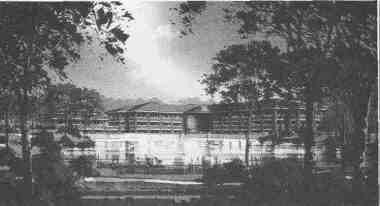
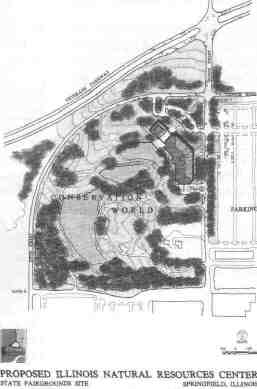
Speaking at the announcement press conference. Dr. Ted Flickinger, executive director of the Illinois Association of Park Districts said: "I commend Governor Edgar for his foresight and tremendous dedication to natural resources. Governor, we salute your dedication. You have made an indelible contribution to parks, recreation and conservation."
46 ¦ Illinois Parks and Recreation
OUR NATURAL RESOURCES NEWS BRIEFS
DNR Offers Financial Assistance for
Greenways and Trails Planning
The DNR now offers a new program to assist communities, counties
and multi-county coalitions with greenway and trail planning. The
program is an extension of successful DNR-assisted greenway and
trail planning for northeastern Illinois and downstate metro areas.
The goal of the program is to encourage and facilitate comprehensive, cooperative and coordinated planning to protect high-priority greenways and, where appropriate, provide public access to them by developing trails. Greenways and trails are linear resources, therefore, protecting greenways and developing trails usually requires cooperation and coordination among several jurisdictions. Greenways are natural resource corridors such as streams that may or may not include trails.
Eligibility
This is the third phase of DNR-assisted greenway and trail planning in Illinois. Phase 1 covered northeastern Illinois. Phase 2 covered 10 downstate metro-areas. Phase 3 covers non-metro communities and counties, including:
• Illinois communities greater than 10, 000 population that have not
already participated in DNR-assisted northeastern Illinois or downstate metro-area greenway and trail planning.
• Illinois counties that have not already participated in DNR-assisted
northeastern Illinois or downstate metro-area greenway and trail planning. These counties may participate in the program individually or
in cooperation with one or more other eligible counties.
• Two or more northeastern Illinois and downstate metro-area coalitions that have (1) completed regional plans (under Phase 2) and (2)
demonstrated significant progress in implementing portions of their
plans. The goal for this planning is to connect metro-area networks.
• Interstate coalitions. The goal for this planning is to connect
greenways and trails within Illinois to greenways and trails within
adjacent states.
Conditions for Assistance
• An active organized coalition (s) of agencies and organizations involved in providing and using greenways and trails. The coalition (s)
must be in place and must be involved in the DNR-assisted plan
from beginning to completion.
• Letters or resolutions of endorsement for the DNR-assisted plan
from a majority of the local units of government in the planning area
(e.g., city councils, county boards, park districts boards). For interstate planning, a memorandum-of-understanding among affected local units of government is required.
• Cost-share by the local sponsor or other coalition members. There
is no required minimum percentage, however, DNR expects the local cost-share to substantively expand the scope of the DNR-assisted
plan.
Required Plan Contents
• DNR-assisted plan must explicitly consider bike trail projects
• DNR-assisted plan must identify priority greenway and trail projects
• DNR-assisted plan must include an action plan identifying sequential activities and responsible parties
• DNR-assisted plan must consider potential linkages to (1) state
sites, especially state trails, (2) greenway and trail initiatives of statewide significance, such as the Grand Illinois Trail, and (3) priority
greenways and trails in neighboring communities, counties, metro
areas and other states, if applicable.
Assistance
• Community greenway and trail planning (max. $20, 000/plan)
• County greenway and trail planning (max $20, 000/plan)
• Multi-county greenway and trail planning (max $20, 000/plan)
• Multi-metro-area or interstate planning (max $15, 000/plan)
• In addition to financial assistance, DNR will provide technical assistance on coalition-building, general planning approach, public involvement, etc., and the Conservation Fund's American Greenways
Program will be available for presentations and consultation.
For More Information, Contact:
Jim Hart, Greenways Program
Illinois Department of Natural Resources
524 S. Second St., Springfield, IL 62706
217.782.3715
217.524.4177 (fax)
greenway@dnrmail.state.il.us
March/April 1998 | 47
OUR NATURAL RESOURCES NEWS BRIEFS
Wildlife Preservation
Fund Seeks Donations
As tax times approaches, supporters of wildlife in Illinois are being
asked to donate to the Illinois Department of Natural Resources'
Wildlife Preservation Fund.
"As you watch the birds visit your backyard feeder or see the tracks of the squirrels and deer during a wind-chilled walk in the park or the woods this winter, take a minute to reflect on the breathtaking beauty of the season," said Illinois Department of Natural Resources Director Brent Manning. "That moments pause will serve as the perfect reminder that we are all responsible for making sure we, our children and our grandchildren can continue to enjoy being outdoors in Illinois."
For the 15th consecutive year, the Illinois Wildlife Preservation Fund will appear on Illinois income tax return forms as a contribution check-off option for taxpayers as they prepare to file their returns in 1998.
"Last year, more than 21, 000 of us made a conscious decision to help enhance the future of wildlife in the state by contributing to the Wildlife Preservation Fund through our state tax return," Manning said. "The wildlife fund remains the most popular check-off on the state tax form because those who contribute realize their investment is helping preserve our natural heritage."
Donations to the Wildlife Preservation Fund in 1997 totaled more than $206, 000. In all, over $2.9 million has been contributed to the fund through the tax check-off during the past 14 years.
Over the course of the next year, donations to the Wildlife Preservation Fund will assist in supporting more than 60 habitat improvement and research projects throughout the state...focusing on everything from endangered grassland birds and threatened frog and turtle populations to stream ecology to rare plant protection to nuisance plant control.
Donations to the Wildlife Preservation Fund are tax deductible and may be made on line 15a of the IL-1040 form or on line 5a of the IL-1040-EZ form. Those taxpayers filing by telephone may donate to the wildlife fund on line 10 of Telefile.
Sporting Series Hits the Streets
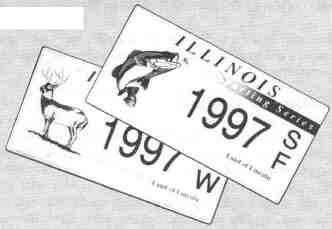
Sporting series license plates featuring a deer and a bass are on
the street. The plates cost $88 for a first-time order, with $25 going for wildlife habitat.
Order forms for the plates are available to all Secretary of State drivers license facilities or by calling toll-free at 1-800- 252-8980. They also can be ordered over the Internet at http: / /www.sos.state.il.us: 80/depts/vehicles/comingpl.html. There are six different types of plates. But plates featuring a goose, duck, pheasant and turkey have not received broad enough interest to make them available yet.
48 | Illinois Parks and Recreation